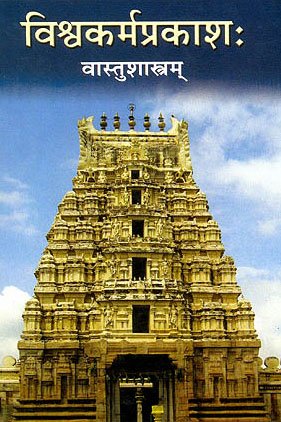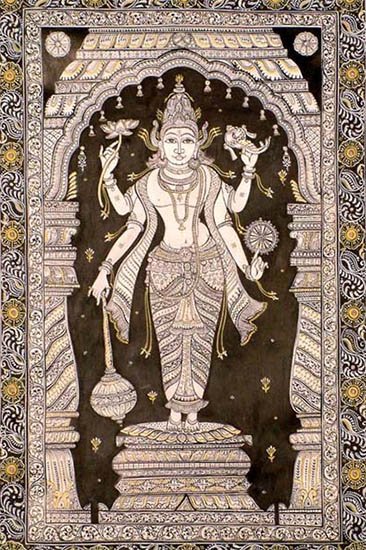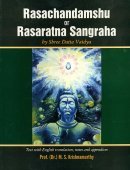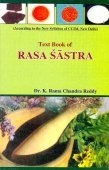Vaidurya, Vaiḍūrya: 25 definitions
Introduction:
Vaidurya means something in Buddhism, Pali, Hinduism, Sanskrit, Jainism, Prakrit, Marathi, Hindi. If you want to know the exact meaning, history, etymology or English translation of this term then check out the descriptions on this page. Add your comment or reference to a book if you want to contribute to this summary article.
In Hinduism
Ayurveda (science of life)
Rasashastra (Alchemy and Herbo-Mineral preparations)
Source: Wisdom Library: Rasa-śāstraVaidūrya (गोमेद, “Cat’s eye (cymophane)”):—One of the nine gems (navaratna) according to the 13th century Rasaprakāśasudhākara.
The Cats’ eye (vaidūrya) has Pharmaco-therapeutic properties and possesses the following characteristics:
- pacifies rakta-doṣa and pitta-doṣa or raktapitta disease,
- promotes intelligence,
- stimulates disgestive fire,
- always destroys pittaroga and malabaddhatā (irregular and constipated bowel habits)
- bearing it gives sukha (pleasure or happiness) to its user
Superior: When the Cats eye’ is possessed of the following characteristics, it is considered superior: Clear, sama (uneven), blackish white, heavy, bright, and containing three white lines in its middle portion just like yajnopavīta.
Inferior: The Cat’s eye is considered inferior when it exhibits the following traits: Rough, light in weight, flat, always looking like śyāmatoya (blackish water), containing red uttarīya like structure in its middle.
Source: Google Books: Iatro-chemistry of Āyurveda, RasaśāstraVaiḍūrya (वैडूर्य, “Cat’s eye”):—Vaiḍūrya is like cat’s eye. It is blue and yellow and exceedingly clean (transparent). Vaiḍūryacures rakta-pitta (a disease characterised by bleeding from different parts of the body). It promotes intellect, longevity and strength. It cures diseases caused by the aggravation of pitta. It stimulates the power of digestion. It alleviates ailments caused by the afflictions by evil planets.
Dietetics and Culinary Art (such as household cooking)
Source: Shodhganga: Dietetics and culinary art in ancient and medieval IndiaVaiḍūrya (वैडूर्य) or Vaiḍūryapātra refers to a type of utensil/vessel (used for food) according to the 17th century Bhojanakutūhala (dravyaguṇāguṇa-kathana), and is commonly found in literature dealing with the topics of dietetics and culinary art, also known as Pākaśāstra or Pākakalā.—Different metallic vessels are described in the text. The vessels/utensils that are made of Vaiḍūrya have the following dietetic effects: pavitra (pure) and śītala (cooling).

Āyurveda (आयुर्वेद, ayurveda) is a branch of Indian science dealing with medicine, herbalism, taxology, anatomy, surgery, alchemy and related topics. Traditional practice of Āyurveda in ancient India dates back to at least the first millenium BC. Literature is commonly written in Sanskrit using various poetic metres.
Vaishnavism (Vaishava dharma)
Source: VedaBase: Śrīmad Bhāgavatam 10.3.9-10The Vaidūrya gem, which sometimes appears bluish, sometimes yellow and sometimes red, is available in Vaikuṇṭhaloka. The Lord’s (Viṣṇu) helmet and earrings were decorated with this particular gem.

Vaishnava (वैष्णव, vaiṣṇava) or vaishnavism (vaiṣṇavism) represents a tradition of Hinduism worshipping Vishnu as the supreme Lord. Similar to the Shaktism and Shaivism traditions, Vaishnavism also developed as an individual movement, famous for its exposition of the dashavatara (‘ten avatars of Vishnu’).
Vastushastra (architecture)
Source: Wisdom Library: Vāstu-śāstraVaiḍūrya (वैडूर्य) refers to a type of temple (prāsāda) classified under the group named Sāndhāra, according to Samarāṅgaṇasūtradhāra chapter 56. The Sāndhāra group contains twenty-five out of a sixty-four total prāsādas (temples) classified under four groups in this chapter. The Samarāṅgaṇasūtradhāra is an 11th-century encyclopedia dealing with various topics from the Vāstuśāstra.

Vastushastra (वास्तुशास्त्र, vāstuśāstra) refers to the ancient Indian science (shastra) of architecture (vastu), dealing with topics such architecture, sculpture, town-building, fort building and various other constructions. Vastu also deals with the philosophy of the architectural relation with the cosmic universe.
Natyashastra (theatrics and dramaturgy)
Source: Wisdom Library: Nāṭya-śāstraVaiḍūrya (वैडूर्य) is a Sanskrit word referring to “cat’s eye” (the precious stone). When constructing the plinth of the stage (raṅgaśīrṣa), of a playhouse (nāṭyamaṇḍapa), there should be jewels and precious stones be placed underneath by expert builders, according to the Nāṭyaśāstra 2.72-74. Accordingly, cat’s eye (vaiḍūrya) is to be put in the south (dakṣiṇā).

Natyashastra (नाट्यशास्त्र, nāṭyaśāstra) refers to both the ancient Indian tradition (shastra) of performing arts, (natya—theatrics, drama, dance, music), as well as the name of a Sanskrit work dealing with these subjects. It also teaches the rules for composing Dramatic plays (nataka), construction and performance of Theater, and Poetic works (kavya).
Purana and Itihasa (epic history)
Source: Cologne Digital Sanskrit Dictionaries: The Purana Index1) Vaiḍūrya (वैडूर्य).—A hill range on the west of Meru.*
- * Viṣṇu-purāṇa II. 2. 29.
2a) Vaidūrya (वैदूर्य).—A mountain on the base of Meru, and west of Śitoda.*
- * Bhāgavata-purāṇa V. 16. 26; Vāyu-purāṇa 36. 27; 42. 50.
2b) An Asura of the Mahātalam.*
- * Vāyu-purāṇa 50. 35.
Vaiḍūrya (वैडूर्य) refers to the name of a Mountain or Tīrtha (pilgrim’s destination) mentioned in the Mahābhārata (cf. III.86.15, III.87.4). Note: The Mahābhārata (mentioning Vaiḍūrya) is a Sanskrit epic poem consisting of 100,000 ślokas (metrical verses) and is over 2000 years old.

The Purana (पुराण, purāṇas) refers to Sanskrit literature preserving ancient India’s vast cultural history, including historical legends, religious ceremonies, various arts and sciences. The eighteen mahapuranas total over 400,000 shlokas (metrical couplets) and date to at least several centuries BCE.
Shilpashastra (iconography)
Source: Shodhganga: The significance of the mūla-beras (śilpa)Vaiḍūrya (वैडूर्य) refers to “cat’s eye” and represents a kind of precious stone (gem) used for the making of images (Hindu icons), as defined in the texts dealing with śilpa (arts and crafs), known as śilpaśāstras.—The materials listed in the Āgamas for the making of images are wood, stone, precious gems, metals, terracotta, laterite, earth, and a combination of two or three or more of the materials specified above. The precious stones mentioned in the Āgamas for the purpose of making images are [for example] vaiḍūrya (cat’s eye).
Precious stones (e.g., vaiḍūrya or ‘cat’s eye’) are preferred materials for fashioning images.—The materials recommended in the śilpaśāstra for the fashioning of images are unburnt clay, burnt clay as in brick or terracotta, sudhā (a special kind of mortar/plaster), composite earth, wood, stone, metal, ivory, dhātu (mineral), pigment, and precious stones. Wood is considered superior to earth, stone as better than wood, metal better than stone, and precious stone (such as vaiḍūrya) is the most preferred of all.

Shilpashastra (शिल्पशास्त्र, śilpaśāstra) represents the ancient Indian science (shastra) of creative arts (shilpa) such as sculpture, iconography and painting. Closely related to Vastushastra (architecture), they often share the same literature.
Shaktism (Shakta philosophy)
Source: Google Books: ManthanabhairavatantramVaiḍūrya (वैडूर्य) refers to a “sapphire”, according to the Śrīmatottara-tantra, an expansion of the Kubjikāmatatantra: the earliest popular and most authoritative Tantra of the Kubjikā cult.—Accordingly, “Then (after that comes the fourth sacred seat [i.e., Kāmarūpa] which) is in the locus of the heart and is surrounded by eight energies, namely Mohā, Āvṛtā, Prakāśyā, Kiraṇā, Rāgavatī, Hṛṣṭā, Puṣṭī, and Krodhā. [...] The venerable Kāmānanda is the emperor in the middle of the Wheel; sustained by the venerable Kāmavatī (the energy of passion) as (his) lordship, in the midst of all the troupes of Yoginīs, (he) generates light with a yellow and red lustre like that of (a freshly) cut sapphire [i.e., bhinna-vaiḍūrya]. (The seat) is surrounded by the tree, creeper, monastery, gesture and cave. One should know (this), the fourth sacred seat, as emanation by means of the (energy of the deity that) emanates in many ways (the creatures) born of eggs, sweat, seeds and wombs. [...]”.

Shakta (शाक्त, śākta) or Shaktism (śāktism) represents a tradition of Hinduism where the Goddess (Devi) is revered and worshipped. Shakta literature includes a range of scriptures, including various Agamas and Tantras, although its roots may be traced back to the Vedas.
Jyotisha (astronomy and astrology)
Source: Wisdom Library: Brihat Samhita by Varahamihira1) Vaidūrya (वैदूर्य) refers to a kind of gem, according to the Bṛhatsaṃhitā (chapter 10), an encyclopedic Sanskrit work written by Varāhamihira mainly focusing on the science of ancient Indian astronomy astronomy (Jyotiṣa).—Accordingly, “If, while Saturn is in Kṛttikā, Jupiter should be in the constellation of Viśākhā, mankind will then become very wicked. If both the planets should be in one and the same constellation, the chief towns will suffer. If Saturn should appear variegated in colour, birds will perish; if yellow, there will be fear from hunger; if of blood colour, there will be wars in the land and if of ashy colour, mankind will be very much at strife. If Saturn should appear as bright as the Vaidūrya gem [i.e., vaidūrya-kānti-vimala] or pure or of the colour of the Bāṇa (a black flower) or Atasī flower, mankind will be happy. Whatever may be the colour of Saturn, the persons who or objects which correspond to the particular colour will suffer”.
2) Vaidūrya (वैदूर्य) or Vaidūryadvīpa refers to an island belonging to “Dakṣiṇa or Dakṣiṇadeśa (southern division)” classified under the constellations of Uttaraphālguni, Hasta and Citrā, according to the system of Kūrmavibhāga, according to the Bṛhatsaṃhitā (chapter 14).—Accordingly, “The countries of the Earth beginning from the centre of Bhāratavarṣa and going round the east, south-east, south, etc., are divided into 9 divisions corresponding to the 27 lunar asterisms at the rate of 3 for each division and beginning from Kṛttikā. The constellations of Uttaraphālguni, Hasta and Citrā represent the southern division consisting of [i.e., Vaidūrya-dvīpa] [...]”.

Jyotisha (ज्योतिष, jyotiṣa or jyotish) refers to ‘astronomy’ or “Vedic astrology” and represents the fifth of the six Vedangas (additional sciences to be studied along with the Vedas). Jyotisha concerns itself with the study and prediction of the movements of celestial bodies, in order to calculate the auspicious time for rituals and ceremonies.
General definition (in Hinduism)
Source: archive.org: Vedic index of Names and SubjectsVaidūrya (वैदूर्य, ‘beryl’) is first found in the late Adbhuta-brāhmaṇa.
In Buddhism
Mahayana (major branch of Buddhism)
Source: Wisdom Library: Maha Prajnaparamita SastraVaiḍūrya (वैडूर्य, “lapis-lazuli”) refers to a type of jewel (ratna), into which the universe was transformed by the Buddha’s miraculous power (ṛddhibala) according to the 2nd century Mahāprajñāpāramitāśāstra (chapter XV). Accordingly, “The other jewels, [viz.,] lapis-lazuli (vaiḍūrya), etc., all come from caves”.
Also, “These jewels (eg, vaiḍūrya) are of three types, Human jewels (manuṣya-ratna), Divine jewels (divya-ratna) and Bodhisattva jewels (bodhisattva-ratna). These various jewels remove the poverty (dāridrya) and the suffering (duḥkha) of beings”.
Source: academia.edu: A Study and Translation of the GaganagañjaparipṛcchāVaiḍūrya (वैडूर्य) (Tibetan: bai ḍū rya) refers to “lapis lazuli” (i.e., a type of jewel or precious stone), according to the Gaganagañjaparipṛcchā: the eighth chapter of the Mahāsaṃnipāta (a collection of Mahāyāna Buddhist Sūtras).—Accordingly: “[...] Then the Bodhisattva Ratnavyūha said to the Bodhisattva Gaganagañja: ‘Son of good family, please pour down rain of all kinds of jewels from the sky’. Immediately after his words, the great rain of immeasurable, incalculable amount of jewels, equal to Mount Sumeru in size, with various kinds of names and colors, poured down from ten directions. To wit, gold, silver, crystal, lapis lazuli (vaiḍūrya), emerald, ruby, white coral, Śrīgarbha gem, stainless jewel, red coral gem, moonstone, sunstone, illuminating gem, brightening gem, Jambū-light gem, fire-light gem, [...]”.

Mahayana (महायान, mahāyāna) is a major branch of Buddhism focusing on the path of a Bodhisattva (spiritual aspirants/ enlightened beings). Extant literature is vast and primarely composed in the Sanskrit language. There are many sūtras of which some of the earliest are the various Prajñāpāramitā sūtras.
In Jainism
General definition (in Jainism)
Source: archive.org: Economic Life In Ancient India (as depicted in Jain canonical literature)Vaiḍūrya (वैडूर्य) refers to “cat’s eye”, and is the name of a type of precious stone (gem or jewel) typically used in ancient India. It is also known by the name Vaiḍūya. Both the king (rājan) and the people used to keep previous stones as a part of their wealth and affluence. The king’s mansion was studded with precious stones of various kinds. The rich people possessed them in large quantity and used them in ornaments and for other purposes. The courtesans (gaṇiya) possessed costly jewels and their chambers were adorned with precious jewels. The palanquins of the kings, nobles and rich persons (śreṣṭhins) were inlaid with costly gems.
There were persons expert in the field of gem and jewels (e.g., vaiḍūrya) called maṇikāras (jewellers). There is a reference of maṇikāra-śreṣṭhin in Rājagṛha who had abundant gems and jewels. Various ornaments of pearls and jewels are mentioned in the texts viz. Kaṇagāvali (necklace of gold and gems), rayaṇāvali (necklace of jewels), muttāvali (necklace of pearls), etc. The above description of the various agricultural, agro-based, mining or forestry occupations clearly depicts the high level of perfection achieved in the respective fields.

Jainism is an Indian religion of Dharma whose doctrine revolves around harmlessness (ahimsa) towards every living being. The two major branches (Digambara and Svetambara) of Jainism stimulate self-control (or, shramana, ‘self-reliance’) and spiritual development through a path of peace for the soul to progess to the ultimate goal.
Languages of India and abroad
Marathi-English dictionary
Source: DDSA: The Molesworth Marathi and English Dictionaryvaiḍūrya (वैडूर्य).—n (Properly vaidūrya S) A turkois or lapis lazuli.
--- OR ---
vaidūrya (वैदूर्य).—n m S A turkois or lapis lazuli.
Marathi is an Indo-European language having over 70 million native speakers people in (predominantly) Maharashtra India. Marathi, like many other Indo-Aryan languages, evolved from early forms of Prakrit, which itself is a subset of Sanskrit, one of the most ancient languages of the world.
Sanskrit dictionary
Source: DDSA: The practical Sanskrit-English dictionaryVaiḍūrya (वैडूर्य).—A cat's-eye gem.
Derivable forms: vaiḍūryam (वैडूर्यम्).
--- OR ---
Vaidūrya (वैदूर्य).—a. (-rī or -ryī f.)
1) Brought from, or produced in, Vidūra.
2) Eminent (śreṣṭha); को न्वयं नरवैदूर्यः (ko nvayaṃ naravaidūryaḥ) Bhāg 1. 55.31.
-ryam [vidūre girau bhavaṃ śyañ] Lapis lazuli; Ku. 7.1; Śiśupālavadha 3.45; भुवि वैदूर्यनकाशशाद्वलायाम् (bhuvi vaidūryanakāśaśādvalāyām) Bu. Ch.5.9; (the cat's-eye gem; cf. mārjārekṣaṇapiṅgalacchavijuṣ Rājanighaṇṭu); स्थाल्यां वैदूर्यमय्यां पचति तिलकणानिन्धनैश्चन्दनाद्यैः (sthālyāṃ vaidūryamayyāṃ pacati tilakaṇānindhanaiścandanādyaiḥ) Bh.
Source: Cologne Digital Sanskrit Dictionaries: Shabda-Sagara Sanskrit-English DictionaryVaidūrya (वैदूर्य) or Vaidūryya.—n.
(-ryaṃ) A gem of a dark colour, the lapis lazuli. E. vidūra said to be the name of a mountain where the stone is found, or a city where it is polished, and ṣyañ aff.
Source: Cologne Digital Sanskrit Dictionaries: Benfey Sanskrit-English DictionaryVaidūrya (वैदूर्य).—i. e. vidūra + ya, I. adj. Brought from Vidūra. Ii. n. A gem of a dark-blue colour, the lapis lazuli, [Bhāgavata-Purāṇa, (ed. Burnouf.)] 4, 25, 15; [Rāmāyaṇa] 3, 49, 2; 53, 15.
Source: Cologne Digital Sanskrit Dictionaries: Cappeller Sanskrit-English DictionaryVaiḍūrya (वैडूर्य).—[neuter] ([masculine]) the cat’s eye (a kind of gem).
--- OR ---
Vaidūrya (वैदूर्य).—v. vaiḍūrya.
Source: Cologne Digital Sanskrit Dictionaries: Monier-Williams Sanskrit-English Dictionary1) Vaiḍūrya (वैडूर्य):—n. (rarely m.; cf. vidūra-ja) a cat’s-eye gem (ifc. ‘a jewel’, = ‘anything excellent of its kind’), [Adbhuta-brāhmaṇa; Mahābhārata; Kāvya literature] etc.
2) m. Name of a mountain (also -parvata), [Mahābhārata; Varāha-mihira’s Bṛhat-saṃhitā] etc.
3) mf(ā)n. made of cat’s-eye gems, [Mahābhārata; Rāmāyaṇa etc.]
4) Vaidurya (वैदुर्य):—[wrong reading] for vaidūrya (or vaiḍūrya), [Mārkaṇḍeya-purāṇa]
5) Vaidūrya (वैदूर्य):—1. vaidūrya mf(ī or rī)n. ([from] vi-dūra) brought from Vidūra, [Pāṇini 4-3, 84.]
6) 2. vaidūrya [wrong reading] for vaiḍūrya.
Source: Cologne Digital Sanskrit Dictionaries: Yates Sanskrit-English DictionaryVaidūrya (वैदूर्य):—(ryyaṃ) 1. n. Lapis lazuli.
[Sanskrit to German]
Sanskrit, also spelled संस्कृतम् (saṃskṛtam), is an ancient language of India commonly seen as the grandmother of the Indo-European language family (even English!). Closely allied with Prakrit and Pali, Sanskrit is more exhaustive in both grammar and terms and has the most extensive collection of literature in the world, greatly surpassing its sister-languages Greek and Latin.
Hindi dictionary
Source: DDSA: A practical Hindi-English dictionaryVaidurya (वैदुर्य):—(nm) baryl, a cat’s eye (gem); also —[maṇi].
...
Kannada-English dictionary
Source: Alar: Kannada-English corpusVaiḍūrya (ವೈಡೂರ್ಯ):—[noun] an azure-blue, opaque semiprecious stone, a mixture of various minerals; lapis lazuli.
--- OR ---
Vaidūrya (ವೈದೂರ್ಯ):—[noun] = ವೈಢೂರ್ಯ [vaidhurya].
Kannada is a Dravidian language (as opposed to the Indo-European language family) mainly spoken in the southwestern region of India.
See also (Relevant definitions)
Starts with: Vaiduryadvipa, Vaiduryagarbha, Vaiduryakanti, Vaiduryamani, Vaiduryamanivant, Vaiduryamanivat, Vaiduryamaya, Vaiduryanirbhasa, Vaiduryaparvata, Vaiduryapatra, Vaiduryaprabha, Vaiduryashikhara, Vaiduryashringa, Vaiduryavat.
Ends with: Bhaishajyaguruvaidurya, Bhinnavaidurya, Indravaidurya.
Full-text (+56): Indravaidurya, Vaiduryamaya, Viduraja, Vaiduryakanti, Vaiduriya, Vaiduryamanivat, Baidurya, Vaiduryashikhara, Vaiduryaprabha, Vaiduryamani, Vaiduryashringa, Vaiduryapatra, Ratna, Vajratulya, Vaituriyam, Mahadanta, Kacamanika, Bhaishajyaguruvaiduryaprabha, Navaratnem, Navaratna.
Relevant text
Search found 59 books and stories containing Vaidurya, Vaidūrya, Vaiḍūrya; (plurals include: Vaiduryas, Vaidūryas, Vaiḍūryas). You can also click to the full overview containing English textual excerpts. Below are direct links for the most relevant articles:
Rasa Jala Nidhi, vol 3: Metals, Gems and other substances (by Bhudeb Mookerjee)
Part 1 - Characteristics of cat’s eye (vaidurya) < [Chapter XIX - Gems (7): Vaidurya (oriental cats eye and similar stones)]
Part 2 - Test of genuine cat’s eye (vaidurya) < [Chapter XIX - Gems (7): Vaidurya (oriental cats eye and similar stones)]
Chapter XIX - Gems (7): Vaidurya (oriental cats eye and similar stones)
Garga Samhita (English) (by Danavir Goswami)
Verse 2.9.29 < [Chapter 9 - Brahmā’s Prayers]
Verses 1.2.32-34 < [Chapter 2 - Description of the Abode of Śrī Goloka]
Tattvartha Sutra (with commentary) (by Vijay K. Jain)
Verse 3.12 - The colours of the mountain chains < [Chapter 3 - The Lower World and the Middle World]
Brihad Bhagavatamrita (commentary) (by Śrī Śrīmad Bhaktivedānta Nārāyana Gosvāmī Mahārāja)
Verse 2.4.142-144 < [Chapter 4 - Vaikuṇṭha (the spiritual world)]
Verse 2.4.46 < [Chapter 4 - Vaikuṇṭha (the spiritual world)]
Yoga Vasistha [English], Volume 1-4 (by Vihari-Lala Mitra)
Chapter V - Narrative of a vidyadhara and his queries < [Book VII - Nirvana prakarana part 2 (nirvana prakarana)]
Cosmetics, Costumes and Ornaments in Ancient India (by Remadevi. O.)
1.2. Materials (g): Vaiḍūrya (Lapis lazuli, cat’s eye) < [Chapter 3 - Ornaments]
2.1. Head Ornaments (a): Kirīṭa < [Chapter 3 - Ornaments]
1.2. Materials: Gems (Introduction) < [Chapter 3 - Ornaments]
Related products

